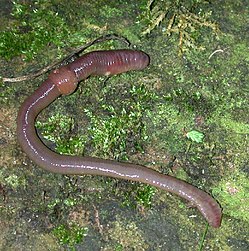Earthworm is the common name for the largest members of Oligochaeta (which is either a class or subclass depending on the author) in the phylum Annelida. The earthworm is the most known worm in America, and other countries. In classical systems they were placed in the order Opisthopora, on the basis of the male pores opening posterior to the female pores, even though the internal male segments are anterior to the female. Theoretical cladistic studies have placed them instead in the suborder Lumbricina of the order Haplotaxida, but this may again soon change. Folk names for the earthworm include "dew-worm", "rainworm", "night crawler" and "angleworm" (due to its use as fishing bait).
Earthworms are also called megadriles (or big worms), as opposed to the microdriles (or small worms) in the families Tubificidae, Lumbriculidae, and Enchytraeidae, among others. The megadriles are characterized by having a multilayered clitellum (which is much more obvious than the single-layered one of the microdriles), a vascular system with true capillaries, and male pores behind the female pores.
The basic body plan of an earthworm is a tube, the digestive system, within a tube, the muscular slimy, moist outer body. The body is annular, formed of segments that are most specialized in the anterior. Earthworms have a simple circulatory system. They have two main blood vessels that extend through the length of their body: a ventral blood vessel which leads the blood to the posterior end, and a dorsal blood vessel which leads to the anterior end. The dorsal vessel is contractile and pumps blood forward, where it is pumped into the ventral vessel by a series of "hearts" (aortic arches) which vary in number in the different taxa. A typical lumbricid will have 5 hearts. The blood is distributed from the ventral vessel into capillaries on the body wall and other organs and into a vascular sinus in the gut wall, where gases and nutrients are exchanged. This arrangement may be complicated in the various groups by suboesophageal, supraoesophageal, parietal and neural vessels, but the basic arrangement holds in all earthworms. These single celled earthworms eat in a unique way: their mouth cavity connects directly into the digestive tract without any intermediate processes. Most earthworms are decomposers feeding on undecayed leaf and other plant matter, others are more geophagous.
(wikipedia.org)


No comments:
Post a Comment